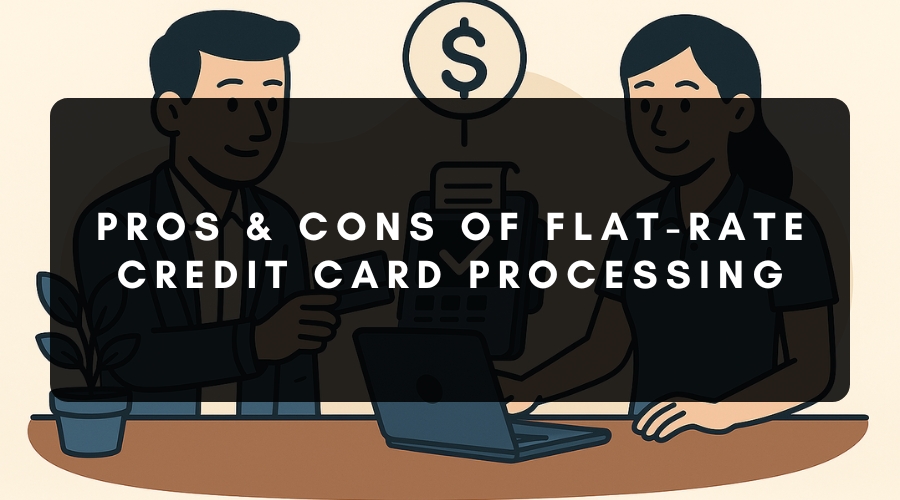
Flat-Rate Credit Card Processing: Pros, Cons, & Tips
Flat-rate credit card processing is a simple way for businesses to handle credit card payments. This fee structure provides peace of mind for merchants who want predictability and transparency. Understanding what flat-rate credit card processing is and how it differs from interchange-plus will help you make an informed choice.
Flat-Rate Credit Card Processing Explained
Flat-rate credit card processing means your business will be charged a fixed percentage per transaction. This may be accompanied by a fixed per-transaction fee.
Flat-rate credit card processing combines all of the costs associated with a credit card transaction, including interchange fees, card scheme fees, and payment processor fees. The rate is not affected by the card type, reward program, or country of issue. This is significant given that credit card processing fees for premium travel and rewards cards can go as high as 4 per cent (compared to an average rate of 2.24 per cent for non-rewards cards).
A flat-rate pricing model is perfect for new or small businesses that do not have the time or resources to research, analyse, and implement complex fee structures. It also makes sense for seasonal businesses that don’t have year-round income to justify paying the flat monthly fee charged under a subscription pricing model.
Many businesses are surprised to find they are paying higher fees than needed with their current pricing structure due to hidden fees in the fine print. Flat-rate payment processing eliminates confusion because it consists of a single clear-cut, dependable fee.
Interchange-Plus vs Flat-Fee Payment Processing
Interchange plus pricing is more complex than flat-rate pricing. With the interchange-plus pricing model, your rate is made up of two parts:
- Interchange fees that go to the card-issuing bank. These fees vary depending on the card type, whether the card is present at the time of the transaction, and other factors.
- A markup fee that goes to the payment processor. This fee is also called a “processor’s markup.”
Interchange-plus pricing offers savings for high-volume businesses and businesses that mostly process low-cost debit transactions. However, the fact that interchange costs are difficult to predict makes this model less attractive to business owners who want simplicity.
Common Myths About Flat-Rate Processing Fees
These common misconceptions may hold business owners back from implementing a flat-rate fee for credit card processing.
“A flat rate is not cost-effective.”
Not always. Flat-rate options may have a slightly higher percentage per transaction but you will avoid other costs, like a monthly subscription fee. Some providers include merchant services like fraud prevention and chargeback mitigation tools in their flat-rate fees. These tools ultimately help you save money.
“Flat-rate pricing is not a professional option for scaling.”
False. Many fast-growing companies choose flat-fee merchant services for a simple, straightforward scaling process.
Tips for Maximising Flat-Rate Success
Try these proven methods for success with flat-rate pricing.
1. Track Your Average Transaction Value
Track your sales and run simulations based on your average transaction value to see which processor’s pricing model is more cost-effective for your business.
2. Choose a Multifaceted Merchant Services Provider
A flat-fee merchant services provider should offer more than just payment processing. Merchant service providers should also provide tools like recurring billing, mobile payments, and support for multiple currencies.
3. Monitor for Growth Highlights
Reassess your pricing as sales volume increases. If your business hits high volumes, renegotiate your rates with your merchant services provider.
Benefits of a Flat-Rate Credit Card Processor
Growing businesses benefit from the ease and simplicity of a flat-rate pricing model. The following are some key advantages of this fee structure.
1. Predictable Costs
Flat-rate processing offers a dependable flat rate for your monthly bills.
Business owners often struggle to understand confusing merchant statements that include varying card types, fees, and surcharges. The flat-rate pricing model removes the speculation.
2. Easier Accounting
The flat-rate pricing structure streamlines bookkeeping and financial planning for businesses.
When businesses have a fixed rate for card processing, it is easier to determine their profit margins. This saves time and energy, and helps business owners avoid unpleasant financial surprises at the end of the month.
3. Fast Setup and Simpler Orientation
Flat-rate payment processing is often quicker to set up than interchange-plus. Fast onboarding is especially valuable for business owners launching a new business, a seasonal venture, or a pop-up store.
4. Great for Consistent Sales Amounts
Businesses with consistent sales amounts benefit the most from flat-rate card processing because they can often negotiate a more competitive rate based on actual costs.
Simply Your Costs With Flat-Rate Fees
A flat-rate credit card processor is a reliable and stress-free choice for many European businesses. This pricing model allows you to avoid hidden fees and confusing merchant statements.
It is not always about finding the lowest possible rate. For many business owners, it’s about the best experience, the fewest surprises, and the greatest assurance from their monthly statements.
Look for a flat-fee merchant service provider that is concerned about your business venture and offers quality customer care and protection. Whether your business is just beginning or you are simplifying an existing fee structure, flat-fee credit card processing companies can help you reach your goals.

